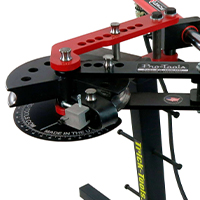

So is draw bending better than roll bending?Īctually they both have their place because they do quite different things. The greater the pressure the tighter the bend.

If the rollers are lightly resting on the tube then it will clearly just pass through them without bending, but as the roller pressure is increased the tube will begin to deform, becoming concave on the side of the single roller as the two outer rollers try to push it around the inner roller. It works by pushing the tube through, normally, three rollers – two on one side of the tube and one, between them, on the other.

This is where roll bending, sometimes called push bending, comes into play. If you need a very gentle curve, ie a large radius of curvature, then draw bending ceases to be feasible since the size of the tooling (and the machine to mount it on) becomes prohibitive. For this reason draw bending is sometimes referred to as mandrel bending.

Some thin wall (relative to diameter or material specification) tubing is liable to collapse when bent and with a draw bending process (in contrast to compression bending) it is possible to support the tube at the point where the bending is taking place by inserting a mandrel down the centre of the tube. The critical considerations, for our purpose, are that the bend tooling must grip the tube precisely in order to pull it around the bend this means that the tooling must be specific to the tube’s external diameter and, the central former around which the tube is drawn must match the required bend this means that the tooling must be specific to the finished tube’s bend radius.
#Tube bending projects full#
Draw Bendingĭraw bending machines can be simple NC (numerically controlled) or full CNC (computer numerically controlled). Draw bending overcomes some of the collapsing problems that can occur with compression bending. In fact, rather than the tube being clamped behind the former it is clamped to the former and the clamp and former rotate with the tube drawn around the former in an arc behind it, just pressed to the former by a pressure die.Īs the name suggests the pressure die is not clamping the tube it is just pressing it against the former but the tube can be drawn along past it. The key difference is that the tooling pulls or draws the tube around the former tool. Once we move to larger diameters and stiffer material, like steel, then machine power becomes essential and draw bending is the normal forming method used. Some quite elaborate shapes can be produced. To produce more complex multi-bend components, for small diameter tube where it is possible to bend it manually, hand bending jigs use compression bending.
#Tube bending projects manual#
The next step up is a simple manual pipe bending tool, a type often used by plumbers for copper tube. Compression tube bendingĬompression tube bending, is akin to bending a copper pipe around your knee you are holding one end of the tube stationary and forming the tube into shape around the former (in this case your knee). There are fundamentally three approaches known respectively as compression bending, draw bending and roll bending. In order to understand the optimum design characteristics for tube bending and manipulation manufacture it is important to appreciate the different methods of tube bending.


 0 kommentar(er)
0 kommentar(er)
